
A hernia is usually treated with surgery. The three main types of hernia surgery are open repair, laparoscopic (minimally invasive) repair, and robotic repair. This article provides details of each procedure .
Open hernia repair is where an incision, or cut, is made in the groin. The hernia “sac” containing the bulging intestine is identified. The surgeon then pushes the hernia back into the abdomen and strengthens the abdominal wall with stitches or synthetic mesh.
Laparoscopic hernia repair uses a laparoscope, a thin, telescope-like instrument that is inserted through a small incision at the umbilicus (belly button). This procedure is usually performed under general anesthesia, so before the surgery, you will have an evaluation of your general state of health, including a history, physical exam and an electrocardiogram (EKG).
Robotic hernia repair, like laparoscopic surgery, uses a laparoscope and is performed in the same manner .Robotic surgery differs from laparoscopic surgery in that the surgeon is seated at a console in the operating room, and handles the surgical instruments from the console.
An inguinal hernia usually happens when fatty tissue or a part of your bowel, such as the intestine, pokes through into your groin at the top of your inner thigh. It pushes through a weak spot in the surrounding muscle wall (the abdominal wall) into an area called the inguinal canal.
Inguinal hernias mainly affect men. Most are thought to be caused by ageing, although they can happen at any age. This is because as you get older, the muscles surrounding your abdomen (tummy) can become weaker.

Copyright © 2022 Dr. Sandhya Bade | All Rights Reserved | Created & Crafted By Itorix Infotech
WhatsApp us